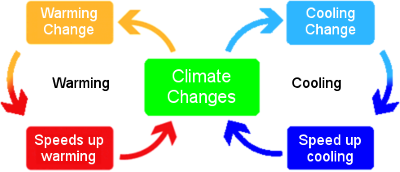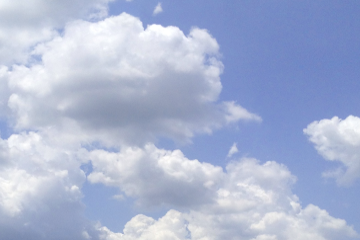What are feedbacks?
All life is subject to feedbacks. When driving the car, if we are tending to veer to the right, we turn the wheel slightly to the left to bring us back along our intended route. In such a way, even though the car will be constantly subject to various forces such as wind, camber, etc. which constantly tend to push it away from the intended direction we then act in the opposite direction to bring it back to our intended route. Moreover, the bigger the deviation, the large we turn the wheel.
This is a form of negative feedback. And as shown below in a schematic for climate temperature if the climate is subject to negative feedback, any change that tends to warm the climate is reduced is scale so that it does not warm as much as it would without these feedbacks. But also any change that tends to cool the climate is also reduced in magnitude. So negative feedbacks tend to reduce the impact of any change.

So negative feedbacks tend to make the climate stable. Or to turn that around a climate that hasn’t changed much for 100s of millions of years despite all the various changes that occur from meteorites to changes in the sun, such as ours, most have large negative feedbacks that tend to keep it as it is.
Positive Feedback
Positive feedback, like negative feedback, tends to be bigger the larger the change. But in this case rather than acting to push the climate back to the state it started, it tends to push in the other way. It is rather like a motor car with a steering wheel that is geared to work so that turning right makes the car go left. Put a normal driver into this car on the straight and their instinct when the car starts to turn right is to turn left. However, because the steering wheel is geared the wrong way, this correction makes the car increase away from the intended route. Any normal driver, put in such a car would start going straight, then as the car started veering off course, rather than correcting the problem, they would tend to make it worse and quickly come off the road.

In the climate, this means that a small warming change would result in an even larger increase in temperature. Unless this feedback is very small (e.g. 1C warming cause less than 1C extra warming) the system is completely unstable and will continue to warm until it hits some kind of limit when this feedback mechanism either disappears or a form of negative feedback comes into place to stop further warming.
But likewise, in a system with positive feedback, unless this positive feedback is very small, the system will end up in runaway cooling until the climate hits a cooling “buffer” and the feedback disappears of a form of negative feedback starts to dominate.
Forms of feedback
Clouds provide the most readily observable forms of feedback (for us in the UK). But they act both to positively increase change and also to reduce it.
Clouds (negative feedback)

The effect of clouds on the climate is the most obvious feedback most of us will experience so regularly that we do not appreciate it as such.
Imagine a warm sunny day. The sun has been shinning through a cloudless sky and so we decide to go outside into the sun.
Then what happens? Sooner or later, that cloudless sky starts to accumulate those fluffy bundles we call clouds. And as the day goes on, they get bigger and bigger until … often it starts pouring with rain.
This is the simplest form of climate feedback. The heat of the sun causes moist air from the surface to rise, this moist air then rises up until either it lose its energy by infra-red emission which cools it stopping its rise, or if the air is moist enough and it rises far enough for expansion and adiabatic cooling to cause the water to condense out of the air, it forms clouds.
And what do these clouds then do? They block the sunshine that was warming the earth that was heating the air and causing it to rise and form clouds. So, the formation of clouds as a result of the sun’s heat, tends to block the sun’s heat causing the surface to be cooler than it would have been.
But it gets worse. Because hot air can hold more moisture, then it clearly is capable of forming more clouds. It also helps that water vapour is lighter than air and tends to help the air rise! So warmer air, tends to hold more moisture, this makes the air lighter and more prone to rise and when warmer air rises it forms more clouds.
In this way (so long as there is enough surface moisture) clouds forming during the day are a strong form of negative feedback.
Clouds (positive feedback)
However, it is also true that clouds provide positive feedback. To understand how this can happen, we need only go outside (in the UK) on a cloudless winter night.

Almost invariably cloudless nights mean frost. And if one takes out an infra-red thermometer when the sky is partly cloudy, we can see the reason why. A cloud might show up with a temperature of around 5C. But the cloudless areas of the sky can read as much as -40C (Note a domestic IR thermometer is not accurate so these are only indicative not the actual temperature).
Here we can see, that in contrast to clouds during the day which tend to block out the sun, clouds at night predominantly act to warm the surface.
But it all depends when the clouds form and when they dissipate. The same clouds that block sunlight during the day leading to negative feedbacks can also cause positive feedback. In some places like the tropics (or even in England in the summer) sunny days tend to end up in stormy nights with dense cloud and thunder. If the day is predominantly clear of clouds which only form late afternoon and the result is that the night is predominantly cloudy, then the same pattern of cloud formation could have most of its affect during the night leading to warming.
Water vapour (positive feedback)
As air gets warmer, its capacity to hold moisture increases. Water vapour is a far more potent greenhouse gas than CO2. So, in theory increasing water vapour in a warmer atmosphere would result in effective trapping of heat and further warming.
Albedo (positive feedback)
Albedo is the amount of light reflected by a surface. A surface with a high albedo, such as snow or sand, will reflect more sunlight back out to space. The lower the albedo, the more energy and heat is absorbed.
If the globe cooled, we would expect ice and snow over a larger area of the surface of the earth. This would reflect more sunlight resulting in the world cooling further. This would (in theory) then lead to increased areas of snow and ice which reflects even more sunlight leading to additional cooling. (Note this is not anywhere near enough for runaway cooling).
Similarly, when leaving the ice-age with large areas under snow and ice. Warming of the globe tends to remove the cover of ice and snow. The darker land surface then absorbs more sunlight leading to warming and so again the effect is positive feedback increasing the amount of warming higher than it would have been.
Variations in the Albedo feedback level
However, the scale of feedback from the albedo effect is very different at different points of the ice-age cycle.
In an interglacial period such as we are experiencing now, there is very little ice and what there is, is situated around the poles where the sun has relatively little impact. So as more and more ice melts it gets increasingly difficult to cause the remaining ice to melt. And a bigger problem is that the further north we go, the less landsurface there is. So the change in albedo of the whole earth reduces considerably for each mile north that melts. So, as the planet warms, the albedo feedback mechanism diminishes in magnitude.
And there is a similar problem at the equator. Here the sun is very high in the sky and as a result it has a very strong impact on temperature. So, even if the rest of the globe were frozen the cooler temperatures elsewhere do not have so much impact at the equator where the sun is strong and so they are very likely to remain unfrozen.
The effect of this is that albedo feedback is strong as the world enters or leaves an ice-age where the ice is forming or melting at moderate latitudes (like Scotland) but it weakens considerably in an interglacial period like the present so that it doesn’t help much (if at all) to increase temperature further, and it is considerably reduced during a glacial, when even a significant cooling of the globe cannot push the ice much further away from the poles because of the intensity of the sun increases too much toward the equator.
However, an even more fundamental problem is that whereas snow and ice that forms over land is largely static, that which forms in the sea is subject to winds and tides. So, even a short period of warming can remove all the sea ice (much of the Arctic ice disappears each year). So even a short warm period can cause the ice to break winds and tides can take it southward allowing it to melt and reverse the cooling affect of accumulated snow and ice effectively resetting the clock.
In contrast, over land, the snow and ice stays largely in the same place. It cannot migrate to warmer climes and so even if there is a warmer period, it will still take time to melt. If the accumulation is thick, this could be longer than the warm period meaning the reduced albedo is still in place and this ice still has a much reduced albedo.
Carbon feedbacks
There are also feedbacks that are believed to increase CO2 in the atmosphere. However not only is the direct effect of CO2 rather small (0.6C for a doubling using the latest HITRAN data for spectral absorption), but when discussing the ice-age cycle, feedback resulting in more CO2 are almost redundant. The reason is that we already know how CO2 changed, so knowing what might increase CO2 levels or not, isn’t helpful when we know what the level was.
However for completeness I’ll list a few:
- Carbon cycle (currently negative feedback)
For every tonne of carbon dioxide (CO2) released into the atmosphere, within a year about half of that will be absorbed by the ocean and land, e.g. through trees and plants. As more CO2 enters the atmosphere, more plants grow on the land and in the ocean increasing the uptake of CO2. - Methane hydrates (positive feedback)
There are very large stores of methane locked away at depth in the ocean. We know the stability of these stores is dependant on temperature. As the oceans get warmer it’s possible this balance could be upset and the stores released — which would be very serious. Methane is more than 20 times as potent as CO2 as a greenhouse gas. - Permafrost methane (positive feedback)
This is a big question mark but also potentially a very big deal. There are very organic rich soils in certain parts of the world. At higher latitudes, these are frozen over by permafrost, and those greenhouse gases are effectively locked away. When the soil thaws due to rising temperatures, these gases could become unlocked and be released as CO2 or methane.

